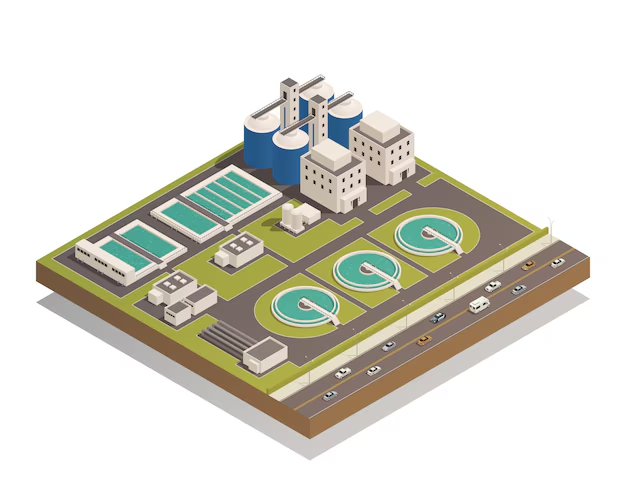Sewage treatment plants are part of today’s sanitation system. They treat wastewater produced by homes, industries, and other trade-related establishments. The world is projected to contain 9.7 billion people by 2050, meaning sewage treatment will become crucial to stop environmental degradation and protect public health.
The World Health Organization reports that improper sanitation causes around 829,000 deaths per year due to diarrheal diseases. Being informed about how STPs function and the steps involved in their installation can be invaluable for communities in adequately handling their wastewater.
So, in this blog, we help you know how sewage treatment plants work, the types of STPs, and step-by-step instructions for installing an STP.

How Sewage Treatment Plants Work
The Treatment Process
A sewage treatment plant includes several operations intended to remove contaminants from water before releasing them back into the environment. Generally, there are three stages in a typical process:
- Preliminary Treatment: The first stage involves screening large solids and debris out using screens and grit chambers. That is, it simply eliminates stuff that would damage equipment or interfere with the treatment processes that follow.
- Primary Treatment: In this step, wastewater is passed into sedimentation tanks where the application of gravity separates the solid from the liquid. The firm sewage settles at the bottom of the tank, leaving liquid effluent to move on for further treatment.
- Secondary Treatment: In this biologically based process, microorganisms break down the organic content in the effluent. Other general processes used are activated sludge processes and trickling filters. The water is then further clarified.
- Tertiary Treatment: In the last step, polishing the effluent brings it up to environmental discharge standards. General methods utilized are filtration, disinfection by ultraviolet light, and the removal of nutrients.
Importance of Sewage Treatment
Proper sewage and wastewater treatment plant is necessary for the following reasons:
- Public Health: Effluents that have been treated do not present health risks associated with waterborne diseases.
- Environmental Protection: Safe effluent for discharge can avoid harmful impacts on the aquatic ecosystem.
- Resource Recovery: Some STPs can recover resources such as biogas from sludge, which is subsequently used to make energy.
Types of Sewage Treatment Plants
- Conventional STPs
Conventional STPs are generally used as a sequential series of mechanical and biological treatment processes of sewage. These types of sewage treatment plants are very much applicable for large communities and industrial purposes, as such plants can handle large quantities of sewage.
- Package STPs
These are prefabricated plants that can be employed in small applications like a residential area or small business establishments. This wastewater treatment plant is compact and can be installed with minimal civil work.
- Decentralized STPs
The decentralized systems pre-treat wastewater near the source; therefore, they are suitable for rural areas or regions where central treatment is a no-go. These types of sewage treatment plants often rely on natural processes like constructed wetlands.
- Advanced STPs
The Advanced waste water treatment plant uses modern technologies such as membrane bioreactors (MBR) or moving bed biofilm reactors (MBBR) to treat wastewater much more efficiently with much less space. The systems are very efficient for nutrient and pathogen removal.
Installation of Sewage Treatment Plant
Step-by-Step Installation Procedure
- Site Evaluation: Conduct a proper evaluation of the site before installing a sewage treatment plant to arrive at soil conditions, groundwater level, and proximity to existing infrastructure before setting up.
- Selection of Design: Select an adequate type of STP according to the quantum of wastewater generation and specific treatment requirements.
- Permits and Legislation: Obtain all necessary permits from the local authorities and ensure conformance to all environmental legislations on Sewage Treatment.
- Excavation and Foundation: Clear excavation at the site with proper specifications as per design and prepare a stable foundation for the STP structure.
- Installation of Components: Assemble and install the tanks, pumps, aerators, and control systems strictly as per the manufacturer’s guidelines.
- Electrical Connection: All the electrical connections are to be done by qualified and authorized persons to the pumps, controls, and monitoring systems.
- Testing: All systems need to be tested stringently to ensure that the plant is commissioned in perfect working condition.
- Training: Operators need to be effectively trained to monitor and maintain the STP after installing a sewage treatment plant.
- Maintenance: A well-defined routine maintenance schedule needs to be undertaken to ensure prime performance in the long term.
Innovative Technologies in Sewage Treatment
The face of a sewage treatment plant has changed dramatically in recent times with the need to achieve higher efficiency and sustainability. Among various novel technologies regarding wastewater treatment, numerous studies have elaborated on the following recently:
- Membrane Bioreactor (MBR) Technology: MBRs couple biological treatment with membrane filtration to produce high-quality effluent suitable for reuse. Energy use for these MBRs is reportedly lowered by as much as 50% compared with other technologies, making this more financially feasible for municipalities.
- Advanced Oxidation Processes (AOP): AOPs break down persistent organic pollutants via reactive species oxygen. AOPs have been established to be a viable treatment process for complex wastewater streams containing pharmaceutical compounds and other resistant contaminants to conventional treatment.
- Artificial Intelligence (AI) and Machine Learning (ML): The integration of AI and ML into wastewater management helps monitor real-time and has predictive analytics. These technologies optimize treatment processes by minimizing energy consumption and providing better decision-making capabilities, ultimately enhancing operational efficiency.
Successful Cases of Optimization
Quite a number of the treatment plants in wastewater have implemented these strategies in a very effective manner:
- In Oakland, California, the East Bay Municipal Utility District (EBMUD) plant lowered its energy intake by 33% through an energy optimization program that upgraded its aeration system and incorporated renewable sources into its operation.
- The City of Bloomington Wastewater Treatment Plant improved its sludge dewatering with more effective polymers to get a 50% reduction in polymer usage and 27% in sludge volume.
These examples, therefore, show that upgrading sewage treatment processes with the leading water treatment plant suppliers improves efficiency, reduces operational costs, and, more importantly, has significantly positive environmental outcomes.
Conclusion
A sewage treatment plant also plays a vital role in protecting public health and our environment by ensuring that water is released back into nature as treated water. These plant systems do not work at all, and their kinds and proper installation procedures, when known, can empower communities to manage their wastewater responsibly.
Indeed, the proper choice of water treatment plant suppliers and best practices in installation and maintenance will guarantee clean and safe water resources for generations to come.


